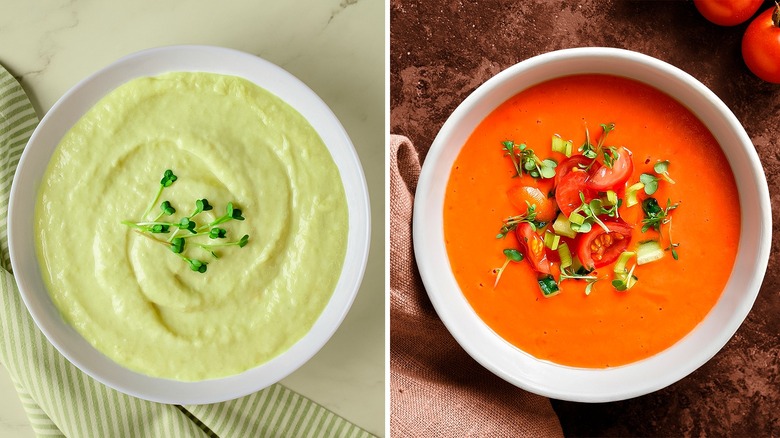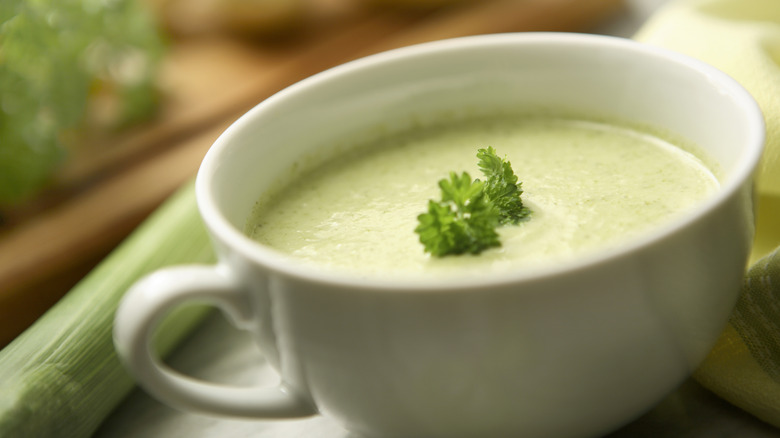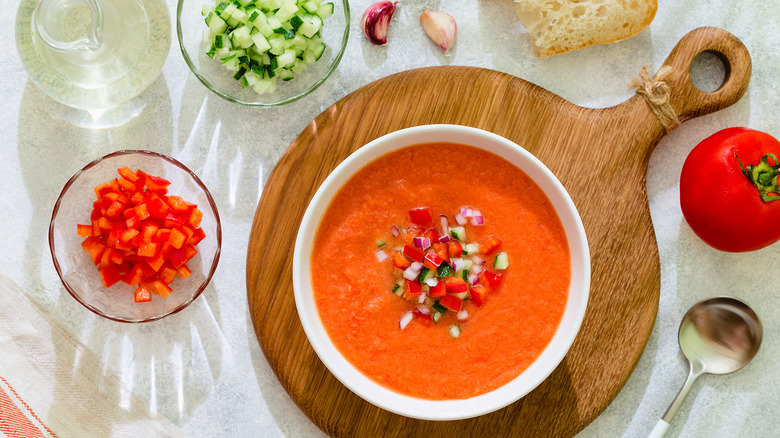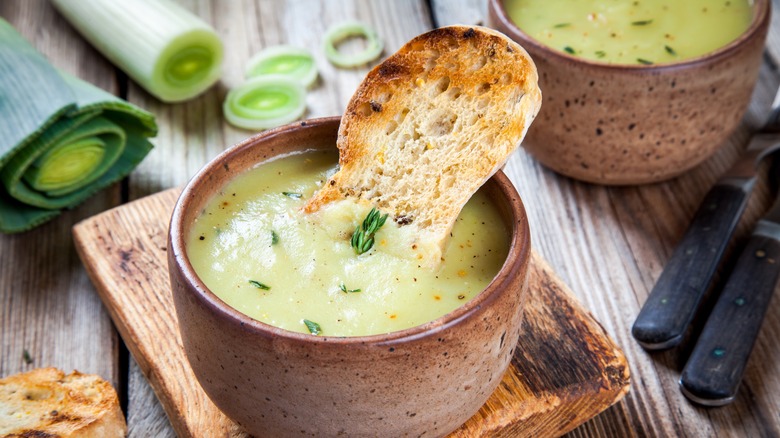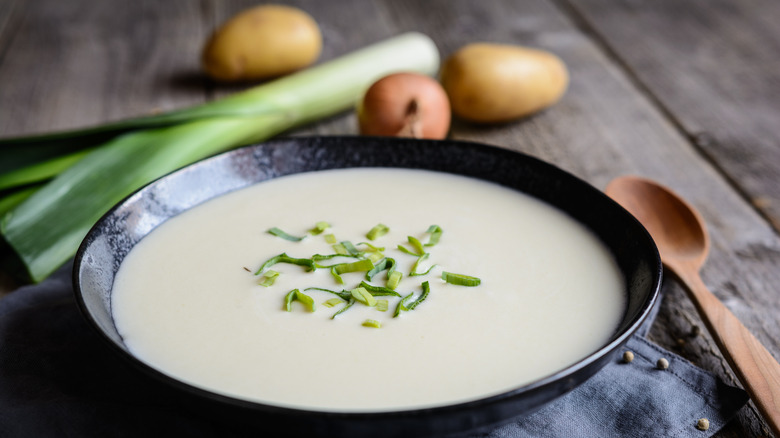The Main Difference Between Vichyssoise And Gazpacho
Vichyssoise and gazpacho are two iconic cold soups that captivate taste buds with their unique blend of ingredients and cultural heritage. Despite their shared chill, these dishes hail from different corners of the culinary world, each boasting its distinct personality. Whether you want to understand these similar dishes or you want to choose the best dish to serve based on the ingredients you have, recognizing the differences can be helpful. From the components used to the texture and flavor, vichyssoise and gazpacho have their fair share of unique qualities.
It quickly becomes clear that these cold soups represent more than just recipes. They are dishes laced with the threads of tradition, innovation, and regional identity. From the refined elegance of vichyssoise to the rustic charm of gazpacho, each dish offers a unique glimpse into the culinary heritage of its respective origins. Let's delve into the tantalizing contrasts between vichyssoise and gazpacho.
What is vichyssoise?
Let's start uncovering these two cold soups with vichyssoise. This luxurious soup, typically made with leeks, potatoes, cream, and chicken stock, traces its roots to the renowned French chef Louis Diat. Born in the town of Montmarault in 1885, Diat left an indelible mark on the culinary world during his tenure at New York's Ritz-Carlton Hotel. Legend has it that Diat drew inspiration from his childhood memories of cold potato and leek soup enjoyed during hot summer days in Vichy, France, thus birthing vichyssoise in the early 20th century.
Vichyssoise tends to have a thick, creamy, and velvety texture thanks to the starches in the potatoes and the added cream. Because potatoes and leeks both have a mild flavor, the soup has a light sweetness thanks to the starring vegetables. Garlic and good broth also add a subtle depth of flavor to the dish. Of course, a wide range of toppings allows you to amp up the flavor as you'd like.
What is gazpacho?
On the other side of the culinary spectrum stands gazpacho, a vibrant concoction that sings of Mediterranean zest. Originating from the Andalusian region of Spain, gazpacho has been a beloved fixture in Spanish cuisine for centuries. This chilled soup boasts a colorful array of ingredients, including tomatoes, bell peppers, cucumbers, onions, garlic, olive oil, vinegar, and bread. Traditionally prepared using a mortar and pestle, gazpacho embodies the essence of rustic simplicity and seasonal abundance, reflecting the sun-drenched landscapes of southern Spain.
Born out of necessity in the scorching summers of southern Spain, gazpacho emerged as a testament to resourcefulness and ingenuity. Originally prepared by laborers in the fields, this dish embodies the essence of Mediterranean simplicity, celebrating the bounty of the harvest in a symphony of vibrant flavors. Over the centuries, gazpacho has evolved from humble peasant fare to a beloved culinary icon, captivating palates with its timeless appeal.
The primary ingredients impact their flavor profiles
As we delve deeper into the heart of these cold soups, it becomes evident that vichyssoise and gazpacho stand as culinary opposites, each embodying a distinct set of flavors, textures, and ingredients.
In the realm of vegetables, vichyssoise leans towards the earthy sweetness of leeks and potatoes, offering a creamy and silky texture that glides across the palate. The gentle nuances of leeks mingle harmoniously with the starchy richness of potatoes, elevated by the indulgent addition of cream. It's a symphony of subtle flavors, where each ingredient plays its part in a delicate dance of refinement.
Conversely, gazpacho bursts forth with the vibrant hues and bold flavors of the Mediterranean. Tomatoes take center stage, their juicy sweetness balanced by the piquant kick of bell peppers and the crisp freshness of cucumbers. Onions and garlic lend aromatic depth, while splashes of vinegar and olive oil add a tangy, acidic finish. The resulting chilled soup celebrates summer's fresh produce with a riot of colors and flavors that are a refreshing delight on even the hottest days. It's a flavor explosion that is the best of bright, sharp flavors — a stark contrast from the mellow sweetness of vichyssoise.
Vichyssoise is creamier than gazpacho
Another defining contrast between vichyssoise and gazpacho can be found in their texture, shaping the overall dish in profound ways. Vichyssoise, with its smooth and velvety consistency — after being cooked and blended — offers a luxurious mouthfeel that caresses the palate. The interplay of cream and potatoes lends a comforting richness, inviting diners to savor each silky bite with unrivaled indulgence.
In contrast, gazpacho delights in its rustic charm and textural complexity. While the base is often blended to a smooth or mostly smooth consistency, the addition of finely chopped vegetables provides a delightful contrast of crunch and silkiness. Cucumbers, bell peppers, and onions lend their crisp bite, creating a symphony of textures that dance upon the tongue with every spoonful. It's a refreshing and invigorating experience that beckons to be savored on a hot summer's day.
Whether you find yourself savoring the velvety depths of vichyssoise or reveling in the vibrant flavors of gazpacho, one thing remains certain, these chilled soups are bound to tantalize your taste buds and leave you craving more. So why not embrace the contrasts, indulge in the flavors, and embark on a culinary adventure through the world of cold soups? After all, there's no better way to beat the heat than with a refreshing bowl of vichyssoise or gazpacho.
